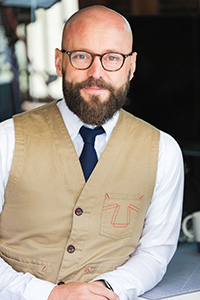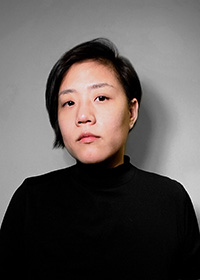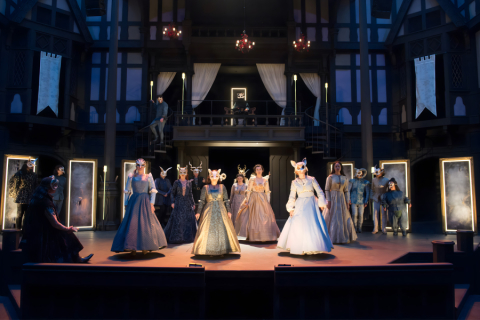Design for the Future
UC Irvine scenic arts faculty revolutionize sustainability in theater
By Christine Byrd
Claire Trevor School of the Arts faculty Efren Delgadillo Jr. and Yee Eun Nam represent a new generation of scenic designers who bring novel approaches to sustainability — avoiding dumpsters full of wood, fabric and other materials at the end of a production. Through their scenic and visual design work, they demonstrate how eco-conscious approaches can redefine the creative process, blending artistry with responsibility.
Efren Delgadillo Jr.
 Efren Delgadillo Jr., associate professor in the Department of Drama, brings a certain scrappy ethos to his design work — whether it’s reusing versatile plastic sheeting over and over in productions, or building a set piece that raises to become a table and lowers to become a bed.
Efren Delgadillo Jr., associate professor in the Department of Drama, brings a certain scrappy ethos to his design work — whether it’s reusing versatile plastic sheeting over and over in productions, or building a set piece that raises to become a table and lowers to become a bed.
With a grant from the Claire Trevor School of the Arts, Delgadillo is building a “Scene Machine” that formalizes sustainability and reuse for UC Irvine set design students. The three-panel aluminum structure will be foldable, portable and lightweight, with modular pieces that can be swapped out for different productions. Sustainability is just one of its benefits.
“It’s sustainable, but it’s also limiting in a way that forces young minds to think creatively and come up with truly poetic ulterior functions and solutions for their designs,” said Delgadillo. “One of the things that I love about theater is that it forces us to use our imagination — and what we're seeing on stage is actually not meant to be reality. It's meant to be a poetic version of it.”
Delgadillo first developed the Scene Machine concept with a colleague while on faculty at California State University, Northridge. When he came to UC Irvine, he created another one, which lasted through two productions before being irreparably damaged. With the new grant from the school, Delgadillo plans to meticulously build the first panel of Scene Machine 3.0, gradually adding to it over time, and incorporating what he’s learned from each version.
“One of the things that I love about theater is that it forces us to use our imagination..."
As a professional set designer, Delgadillo is no stranger to iterations. The set design that landed him on the cover of Live Design magazine in 2013 required over a dozen revisions. Ultimately, the 25-foot wide, five-ton metal wheel he created had to be lifted by crane into the amphitheater at the Getty Villa, where it was the centerpiece of Prometheus Bound directed by Travis Preston.
The technical aspects of building the giant, gently rotating metal wheel came easily to him. Delgadillo grew up in Los Angeles fixing cars and motorcycles alongside his dad, who often used sheet metal to make containers and organizers around their home. Delgadillo continued working with his hands as an undergraduate at UC Irvine, where he majored in studio art. By the time he graduated in 2000, he was already working backstage in productions in the drama department. He went on to earn an M.F.A. in scenic design from California Institute of the Arts.
Over the last two decades, Delgadillo has designed sets for productions across the country, from Romeo & Juliet at the Oregon Shakespeare Festival to American Mariachi at South Coast Repertory, while also serving as resident set designer for the Poor Dog Group ensemble for a decade. While plenty of the productions have had big budgets, Delgadillo says a tendency toward saving and reusing is embedded in his practice. It’s a trend he sees among students, too.
“Both our grad and undergrad students are willing to rummage — they don't shy away from using cardboard to fulfill an idea,” said Delgadillo. “They're adventurous and thoughtful in many ways, including through materials they choose, and I love that about them.”
Yee Eun Nam
 Set and projection designer Yee Eun Nam doesn’t print hundreds of pages of scripts at the beginning of a production or store massive stage flats at the end of a run. In fact, most of her work fits in the palm of her hand, on a hard drive.
Set and projection designer Yee Eun Nam doesn’t print hundreds of pages of scripts at the beginning of a production or store massive stage flats at the end of a run. In fact, most of her work fits in the palm of her hand, on a hard drive.
“Working in digital makes everything more compact and requires less space for me to work – which actually suits my personality,” said Nam, an assistant professor of drama. She joined the Claire Trevor School of the Arts in fall 2024, during the Broadway run of Yellow Face, starring Daniel Dae Kim and featuring Nam’s documentary-style projection design.
The increasing popularity of digital sets and video projection on stages around the world is partly driven by the desire to cut waste by using fewer materials. It also reflects audiences’ embrace of digital media in real life and the array of artistic avenues the digital world opens for designers like Nam.
"Working in digital makes everything more compact and requires less space for me to work..."
“This generation was born and raised with videos, so people tend to appreciate or even expect an immersive theater experience that includes new media,” said Nam. “I’m seeing a lot of productions starting to incorporate video and projection in addition to a set.”
In college, Nam studied design, where she worked in metal craft, ceramics, sculpture and video. Her video skills became instrumental as she was earning her M.F.A. in scenic design at UCLA and a show staged in an art museum required video projections to advance the storytelling and evoke emotion.
As she established her reputation in the industry, working on productions in Southern California and across the country, she especially distinguished herself in work featuring American history. She often draws from archival videos and photos to artfully support the story with projections.

Image: The Mountaintop performed at Geffen Playhouse, featuring Nam’s projection design work. Photo by Isaak Berliner.
In 2020, Nam won the Los Angeles Drama Critics Circle Award for CGI/Video for Mother of Henry and won again in 2023 for Twilight: Los Angeles, 1992, at the Mark Taper Forum — where she worked alongside Efren Delgadillo Jr. For Twilight, Nam had to sift through hours of archival photos and videos from the Los Angeles riots — including violent scenes — to select more than 300 images for the on-stage projections.
“The show was so beautiful, but because the contents were so violent and painful to me, I had to learn about setting my own boundaries as a designer,” said Nam.
Nam’s favorite production is X: The Life and Times of Malcolm X. Working with director Robert O’Hara and set designer Clint Ramos, she helped create the opera’s Afrofuturistic look with video projections, including re-envisioning famous scenes like Malcolm X’s speech outside of the National Memorial Bookstore in Harlem.
“I had the freedom to work with the historical text without being literal about it, so I made a monolith style 3-dimensional text filling the walls as Malcolm X speaks,” explained Nam. “As a designer with a fine art background, it was really fun for me to create some of these moments.”
When the production opened at New York’s storied Metropolitan Opera in 2023, it fulfilled Nam’s biggest career dream: having her work at The Met. Just a few years earlier, she had declared she would retire after doing a production at the opera house. But she achieved the milestone much too soon for that. Instead of retiring, Nam continues bringing her visions to theaters and teaching her art to a new generation of artists at UC Irvine.
To learn more about the faculty and productions in the Department of Drama, visit drama.arts.uci.edu.
Please visit our secure direct giving page and make a gift to support CTSA today!

